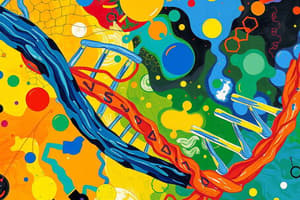Podcast
Questions and Answers
What is the function of the special initiator tRNA?
What is the function of the special initiator tRNA?
- To transcribe DNA
- To replicate DNA
- To synthesize proteins
- To recognize the initiating AUG (correct)
What is the initiating AUG recognized by?
What is the initiating AUG recognized by?
- An amino acid
- A ribosome
- A special initiator tRNA (correct)
- A protein
What is the role of the initiation primer in DNA synthesis?
What is the role of the initiation primer in DNA synthesis?
- To provide a free OH group for the formation of phosphodiester bonds (correct)
- To unwind the double helix structure
- To proofread the newly synthesized strand
- To hydrolyze the dNTPs into nucleotides
What type of molecules are eukaryotic and prokaryotic tRNA made from?
What type of molecules are eukaryotic and prokaryotic tRNA made from?
What does each of the A P E sites extend?
What does each of the A P E sites extend?
What type of bond is formed between the incoming nucleotide and the primer during DNA synthesis?
What type of bond is formed between the incoming nucleotide and the primer during DNA synthesis?
Why are longer precursor molecules necessary for making tRNA?
Why are longer precursor molecules necessary for making tRNA?
What is the molecule that is added to the growing DNA strand during synthesis?
What is the molecule that is added to the growing DNA strand during synthesis?
What is the significance of the initiating AUG?
What is the significance of the initiating AUG?
What process is necessary for making functional tRNA?
What process is necessary for making functional tRNA?
At which end of the primer does the addition of nucleotides occur during DNA synthesis?
At which end of the primer does the addition of nucleotides occur during DNA synthesis?
What is the relationship between the initiating AUG and the special initiator tRNA?
What is the relationship between the initiating AUG and the special initiator tRNA?
What is common between eukaryotic and prokaryotic tRNA?
What is common between eukaryotic and prokaryotic tRNA?
What is the resulting product of the DNA synthesis reaction?
What is the resulting product of the DNA synthesis reaction?
What is the purpose of modifying precursor molecules for tRNA?
What is the purpose of modifying precursor molecules for tRNA?
What is the mechanism of action of many antibacterial agents?
What is the mechanism of action of many antibacterial agents?
What is the function of tRNA in the process of protein synthesis?
What is the function of tRNA in the process of protein synthesis?
What is a characteristic of hnRNAs?
What is a characteristic of hnRNAs?
What is a limitation of mRNA in the process of protein synthesis?
What is a limitation of mRNA in the process of protein synthesis?
What is the role of the codon sequence in protein synthesis?
What is the role of the codon sequence in protein synthesis?
What type of genes are not tightly controlled?
What type of genes are not tightly controlled?
What is the main function of inducible genes?
What is the main function of inducible genes?
What is characteristic of housekeeping genes?
What is characteristic of housekeeping genes?
What type of genes are involved in specific momentary functions?
What type of genes are involved in specific momentary functions?
What is the difference between housekeeping genes and inducible genes?
What is the difference between housekeeping genes and inducible genes?
Flashcards
Initiator tRNA
Initiator tRNA
A special type of tRNA that recognizes the initiating AUG codon, starting the process of translation.
Initiating AUG
Initiating AUG
The first codon in a messenger RNA (mRNA) sequence that signals the start of protein synthesis.
Initiation Primer
Initiation Primer
A short sequence of nucleotides that provides a free 3'-OH group for the attachment of the first nucleotide in DNA synthesis. It acts as a starting point for DNA polymerase.
tRNA Modification
tRNA Modification
Signup and view all the flashcards
tRNA (Transfer RNA)
tRNA (Transfer RNA)
Signup and view all the flashcards
mRNA (Messenger RNA)
mRNA (Messenger RNA)
Signup and view all the flashcards
Translation
Translation
Signup and view all the flashcards
Codon
Codon
Signup and view all the flashcards
A, P, E Sites
A, P, E Sites
Signup and view all the flashcards
Phosphodiester Bond
Phosphodiester Bond
Signup and view all the flashcards
Transcription
Transcription
Signup and view all the flashcards
Okazaki Fragment
Okazaki Fragment
Signup and view all the flashcards
Precursor tRNA
Precursor tRNA
Signup and view all the flashcards
RNA (Ribonucleic Acid)
RNA (Ribonucleic Acid)
Signup and view all the flashcards
Growing DNA Strand
Growing DNA Strand
Signup and view all the flashcards
Antibacterial Agents
Antibacterial Agents
Signup and view all the flashcards
Housekeeping Genes
Housekeeping Genes
Signup and view all the flashcards
Inducible Genes
Inducible Genes
Signup and view all the flashcards
hnRNA (Heterogeneous Nuclear RNA)
hnRNA (Heterogeneous Nuclear RNA)
Signup and view all the flashcards
Splicing
Splicing
Signup and view all the flashcards
Gene
Gene
Signup and view all the flashcards
Introns
Introns
Signup and view all the flashcards
Exons
Exons
Signup and view all the flashcards
Study Notes
DNA Polymerization
- Okazaki fragments are produced in the strand, forming hybrid fragments.
- Deoxyribonucleoside triphosphates (dNTP) are added to the 3'-end of the initiation primer, forming a phosphodiester bond with the incoming nucleotide.
RNA Synthesis
- Both eukaryotic and prokaryotic tRNA are synthesized from longer precursor molecules that require modification.
- tRNA acts as an adaptor, directing specific amino acids according to the codon sequence, as mRNA cannot bind amino acids.
- Initiator tRNA recognizes the initiating AUG.
Gene Regulation
- Housekeeping genes are not regulated, as they are essential for basic cellular functions.
- Inducible genes are tightly controlled in most cells, only activated for specific momentary functions.
RNA Structure
- hnRNAs are mRNAs containing different sets of introns.
Studying That Suits You
Use AI to generate personalized quizzes and flashcards to suit your learning preferences.




